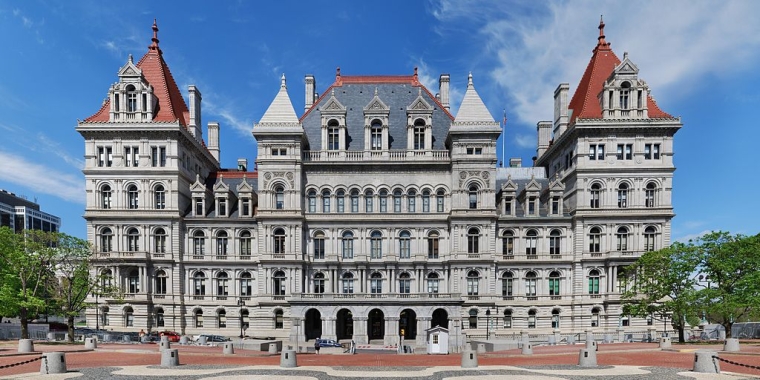
Testimony Before the Department of Sanitation Regarding the Draft Environmental Impact Statement for the Comprehensive Solid Waste Management Plan on December 20th, 2004
Liz Krueger
July 12, 2010
Good evening. My name is Liz Krueger and I am the State Senator for New York’s twenty-sixth senatorial district, one primarily comprising parts of Manhattan’s Midtown and East Side. I would like to thank the Department of Sanitation (DSNY) for hosting this public hearing and allowing me to speak.
I was alarmed when initially notified of DSNY’s intention to resume operation at the 91st-Street marine transfer station (MTS), and I testified in June to express this dismay. The Draft Environmental Impact Statement (DEIS) does not appear to have regarded my concern or that of many community leaders and residents as legitimate, because many of the reasonable questions that were originally posed remain inadequately addressed or ignored. And while I support incorporating marine transfer stations into the City’s waste disposal solution and believe that we must be responsible for our own garbage, placing one at the proposed site still seems irresponsible and myopic.
There must be a better site on the East Side for such a facility. The residential character of the surrounding neighborhood and the presence of Asphalt Green—a unique City resource—adjacent to the MTS site make 91st Street an inappropriate location. Furthermore, the DEIS sets inadequate parameters for a final environmental impact statement that, as of now, will neglect both the full capacity of the MTS site and, subsequently, a comprehensive examination of the MTS impact and required mitigation. To be blunt, an MTS located at 91st Street will have deleterious effects on area traffic, odor, noise, air quality, public health, the character of the neighborhood, and the vitality of Asphalt Green.
The DEIS severely neglects the maximum operational capacity of the converted MTS at 91st Street, forecasting that it will receive only 1,700 tons of trash per day despite possessing the capacity to accommodate 4,290 tons. I assume that the City, currently grappling with a financial shortfall, would not waste its money by erecting a facility that it intended to underutilize. Thus, it seems reasonable that a converted MTS at 91st Street would accept far more waste than the seemingly disingenuous forecast.
An MTS receiving 4,290 tons of trash from four community boards would operate six days a week and receive trucks throughout the day and night. On peak collection days, the MTS would receive 469 delivery vehicles, not the 130 projected. On off-peak days, the site would still need to accommodate—given a conservative assumption of 15-percent less traffic—398 trucks, or seventeen per hour. All trucks would drive straight through Asphalt Green. In order to go through the site, unload its contents into non-spill containers, turn around, and then exit, each truck would require more than the three-and-one-half-minutes average that the current plan would allow. Reconfiguring a few intersections or altering some traffic light patterns seem like hopeless remedies for this potential plague.
As trucks took longer to unload their cargo, those that arrived later would begin to line-up along the delivery routes—the narrow streets running east-west and congested York Avenue, a thoroughfare that already barely accommodates two bus routes, FDR Drive access, and a high volume of cars. While idling, waiting to unload the waste that they carried, the trucks would be sitting with their motors running; releasing carbon-, nitrogen-, and sulfur-based pollutants; emitting pungent odors; and creating a din. This situation would cause problems for which there is no adequate mitigation. And if you think that driving on York Avenue is already frustrating, wait until there are standing trucks constantly clogging the road; if you currently enjoy a restful evening of sleep, remember it fondly as diesel engines roar throughout the night.
Beyond the environmental and quality-of-life problems that the MTS would cause at this location, there would also exist a significant threat to public health. With dozens of schools sending thousands of children to Asphalt Green for recreational activities, permitting heavy polluters like diesel-fuel trucks to constantly idle near the site and imperil a population particularly susceptible to respiratory ailments is not only unsafe but negligent.
Unfortunately, the DEIS neglects this realistic scenario, instead relying upon a series of complex measurements to justify a plan that seems to have been chosen long before the impact study process was even undertaken. If the City is serious about its need to reduce waste and find better ways to accommodate it, there are a number of alternatives that should be included in the Solid Waste Management Plan (SWMP). It could start by supporting state-level efforts, like my “bottle bill,” to expand recycling programs, increase bottle deposits, and cover more types of beverage containers. This would create a dedicated revenue stream that could preserve and promote City recycling, insulating it from the often-senseless budgeting process. New York could also decrease its waste stream by cutting back the distribution of unwanted direct mail and catalogues. Managing bulk waste would also behoove the City, and implementing a system to redistribute items like computers, bicycles, and furniture could potentially result in a 15-percent reduction of the waste stream. City agencies could also adopt a waste-prevention incentive program because these arms of government get free collection services.
There are a number of alternatives to be explored, and while the specifics of the strategy may be cause for disagreement, a consensus has emerged that the DEIS is inadequate, perhaps disingenuous. Thank you very much for your time.
Share this Article or Press Release
Newsroom
Go to NewsroomSenator Krueger's February 2025 Update
February 28, 2025


Statement from Senator Liz Krueger On Mayor Eric Adams
February 18, 2025
